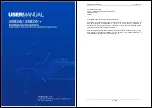
Contatto
ModDMX
Sceneries, inclusion and exclusion of channels
The function for inclusion and exclusion of a channel from a
scenery allows the independent management of different
rooms using the same ModDMX module. In other words,
this feature allows to recall a scenery, e.g. related to a
room to which some DMX channels have been reserved,
avoiding to influence the current status of the other rooms
to which some other channels have been reserved.
The codes 102 and 103 (0x66 and 0x67) allow to select
which DMX channels will be included in the scenery under
construction. The less significant byte written at the output
address specifies the number of the DMX channel to be in-
cluded or excluded.
The codes 101 and 111 (0x65 and 0x6F) allow to store and
recall up to 64 sceneries. The less significant byte written
at the output address specifies the number of the scenery
to be saved or recalled.
The following simple equation stores 3 sceneries (1, 2 and
64) at the pushing of 3 different buttons (I1.1..I1.3) and it
recalls them by other 3 buttons (I1.4..I1.6):
AO3:1
= P(
0x6501
)
I1.1
& P(
0x6502
)
I1.2
& \
P(
0x6540
)
I1.3
&
P(
0x6F01
)
I1.4
& \
P(
0x6F02
)
I1.5
& P(
0x6F40
)
I1.6
To include the channel NN in the scenery, send the com-
mand 0x66NN. If NN = 0 then all the channels will be inclu-
ded.
To exclude the channel NN in the scenery, send the com-
mand 0x67NN. If NN = 0 then all the channels will be ex-
cluded.
Enable and disable DMX flux
To enable and disable the communication (or flux) from
ModDMX to the connected DMX devices, commands 113
and 112 can be respectively used (0x71 and 0x70). This al-
lows to execute a sequence of DMX commands in a unique
flux, in order to avoid undesired effects. The following script
shows an example of the using of this command for the
control of DMX flux.
script
1
trigger
=
I1.1
AO3
=
0x7000
AO3
=
0x01FF
AO3
=
0x02FF
AO3
=
0x03FF
AO3
=
0x7100
endscript
At the activation of the input
I1.1
the script executes, in
the sequence, the following functions:
✗
disabling of DMX flux
✗
loading in the memory of ModDMX of 3 values into 3
different DMX channels (but these ones will not be still
sent to the connected devices because the flux is dis-
abled)
✗
enabling of DMX flux: at this point ModDMX will trans-
fer the value of the channels to the connected devices
Set minimum and maximum value
The commands 135 and 136 (0x87 and 0x88) allow to set a
minimum and a maximum value on all DMX channel for the
functions Up, Down and Single Command.
Broadcast command
The command 255 allows to send a value to all DMX chan-
nels at the same time.
Sceneries management by MCP IDE
As said, ModDMX module can store and recall up to 64
sceneries. This paragraph describes the management of
these sceneries and other functions by the specific config-
uration panel (or tool) inside MCP IDE software package
(
release 3.0.0 or higher
); in this case the management of
ModDMX will be executed by a PC connected to the
Cont-
atto
bus through MCP XT.
Notes:
✗
ModDMX module can work only if the MCP XT controller has
been installed; the configuration and the programming of
MCP XT requires the software package MCP IDE release
3.0.0 or higher.
✗
Take in account that the main purpose of DMXTools program
is for the sceneries management during the setting up and
the maintenance of the plant; it is also useful as “evaluation
program” to get confidence with ModDMX module, but the
“real” management of the plant must be executed by a proper
supervision program taking in account the global require-
ments of the structure property.
To use the tools, all ModDMX modules installed in the plant
must be declared in the MCP XT configuration, specifying
the addresses as in the following example:
MODDMX
= (
O100
)
MODDMX
= (
O101
)
MODDMX
= (
O102
)
… … … …
From the menu of MCP IDE select Programming, then
Module Configuration and then MODDMX 2.x. The window
in Figure 1 will be shown.
This panel features 64 sliders, each one related to the first
DMX channels, and an additional slider (T) for the adjust-
ment of the “Fade” or ramp time. The text box on the upper
left corner of the window (
) allows
to enter the address of the module to be managed.
Each slider reports the number of the DMX channel
to which it is referred (1 in the example of the figure
on this left side) and it allows to change the value of
the channel playing by the mouse on the cursor of
the slider (holding down the left button); the value of
the channel is also displayed by the number on the slider
(80 in the example). As an alternative, it is possible to
double click on the value to enter the desired value and
then press Enter on the keyboard.
DUEMMEGI
s.r.l. - Via Longhena, 4 - 20139 MILANO
Tel. 02/57300377 - Fax 02/55213686 –
www.duemmegi.it
Rel.: 2.2 December 2013
Page 4 of 7
HOME AND BUILDING AUTOMATION

























